steering ASTON MARTIN DB7 1997 Workshop Manual
[x] Cancel search | Manufacturer: ASTON MARTIN, Model Year: 1997, Model line: DB7, Model: ASTON MARTIN DB7 1997Pages: 421, PDF Size: 9.31 MB
Page 3 of 421
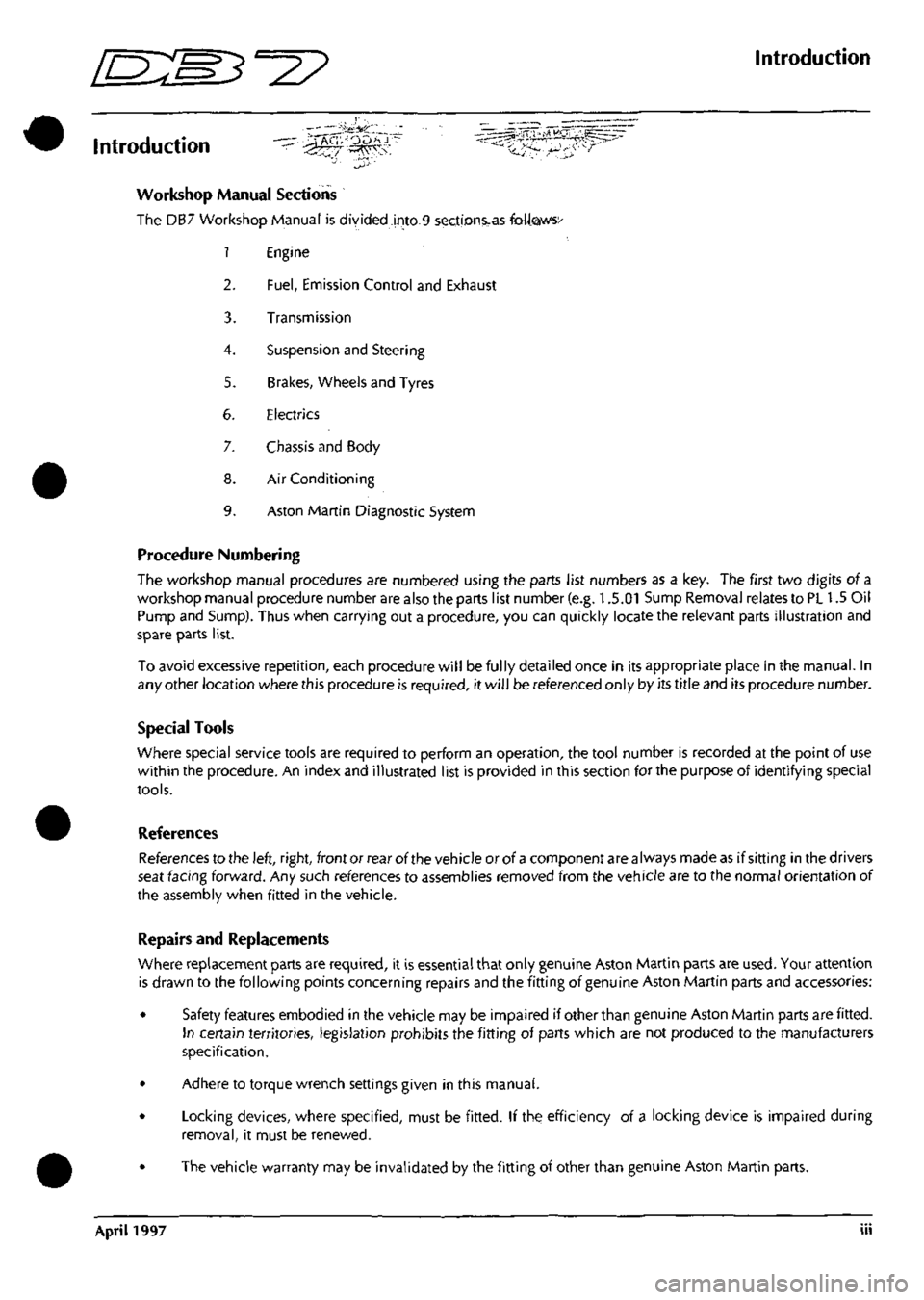
^?
Introduction
#
••t
*<;'..
Introduction '-^;^'^<-~'
^--"^^zfjj^^T^""
Workshop Manual Sections
The
DB7
Workshop Manual
is
divided .jnto,9seGtipnsE.a&foli
1 Engine
2.
Fuel,
Emission Control
and
Exhaust
3. Transmission
4.
Suspension
and
Steering
5. Brakes, Wheels
and
Tyres
6. Electrics
7. Chassis
and
Body
8.
Air
Conditioning
9. Aston Martin Diagnostic System
Procedure Numbering
The workshop manual procedures
are
numbered using
the
parts list numbers
as a key. The
first
two
digits
oi a
workshop manual procedure number
are
also
the
parts list number
(e.g.
1.5.01
Sump Removal relates
to PL 1.5 Oil
Pump
and
Sump). Thus when carrying
out a
procedure,
you can
quickly locate
the
relevant parts illustration
and
spare parts list.
To avoid excessive repetition, each procedure will
be
fully detailed once
in its
appropriate place
in the
manual.
In
any other location where this procedure
is
required,
it
will
be
referenced only
by its
title
and its
procedure number.
Special Tools
Where special service tools
are
required
to
perform
an
operation,
the
tool number
is
recorded
at the
point
of use
within
the
procedure.
An
index
and
illustrated list
is
provided
in
this section
for the
purpose
of
identifying special
tools.
References
References
to the
left, right, front
or
rear
of
the vehicle
or of
a component
are
always made as
if
sitting
in the
drivers
seat facing forward.
Any
such references
to
assemblies removed from
the
vehicle
are to the
normal orientation
of
the assembly when fitted
in the
vehicle.
Repairs
and
Replacements
Where replacement parts
are
required,
it is
essential that only genuine Aston Martin parts
are
used. Your attention
is drawn
to the
following points concerning repairs
and the
fitting
of
genuine Aston Martin parts
and
accessories:
• Safety features embodied
in the
vehicle
may be
impaired
if
other than genuine Aston Martin parts
are
fitted.
In certain territories, legislation prohibits
the
fitting
of
parts which
are not
produced
to the
manufacturers
specification.
• Adhere
to
torque wrench settings given
in
this manual.
• Locking devices, where specified, must
be
fitted.
If the
efficiency
of a
locking device
is
impaired during
removal,
it
must
be
renewed.
•
The
vehicle warranty
may be
invalidated
by the
fitting
of
other than genuine Aston Martin parts.
April
1997 Hi
Page 9 of 421
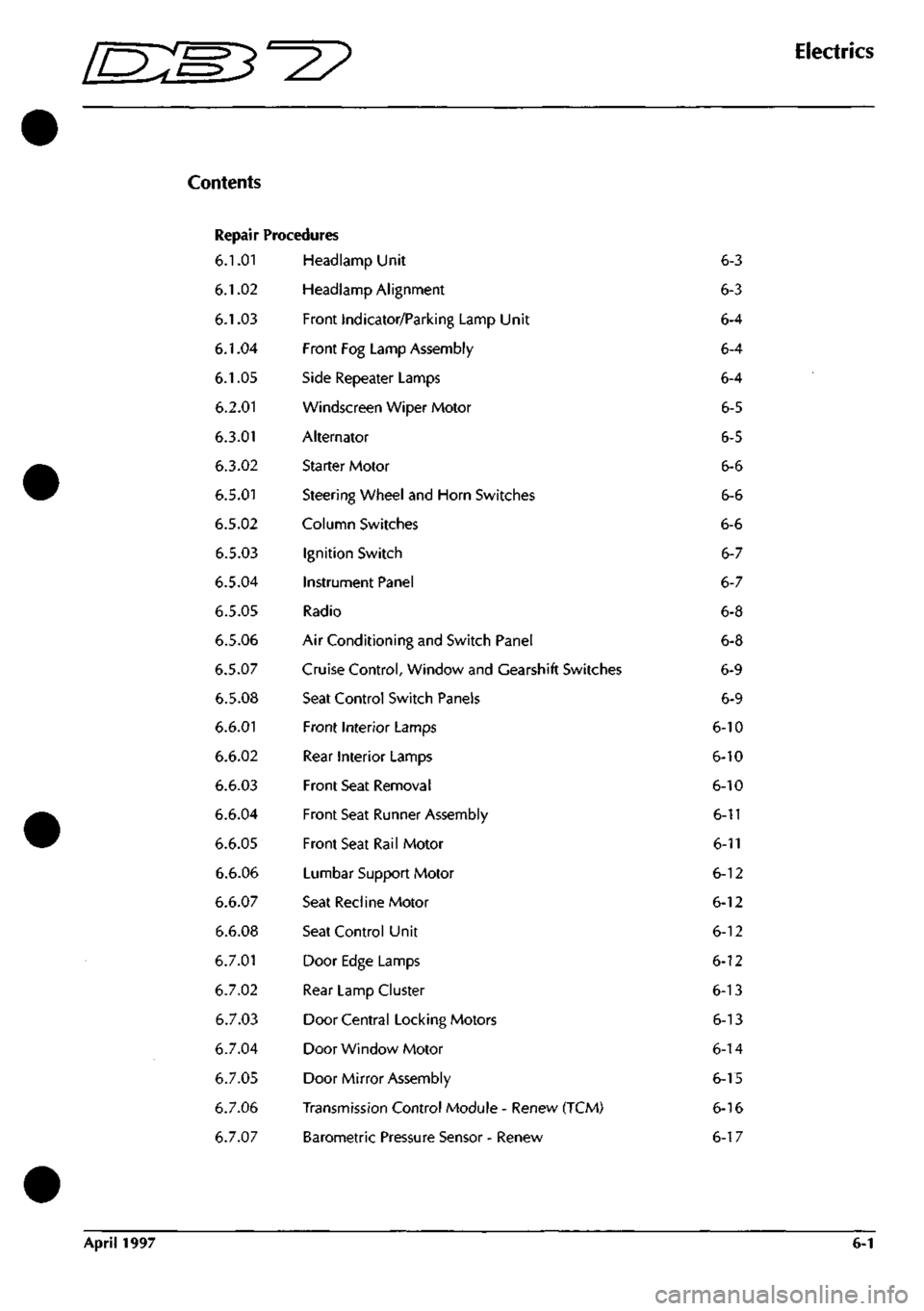
[Em^^^?
Electrics
Repair Procedures
6.1.01
6.1.02
6.1.03
6.1.04
6.1.05
6.2.01
6.3.01
6.3.02
6.5.01
6.5.02
6.5.03
6.5.04
6.5.05
6.5.06
6.5.07
6.5.08
6.6.01
6.6.02
6.6.03
6.6.04
6.6.05
6.6.06
6.6.07
6.6.08
6.7.01
6.7.02
6.7.03
6.7.04
6.7.05
6.7.06
6.7.07
Headlamp Unit
Headlamp Alignment
Front Indicator/Parking Lamp Unit
Front Fog Lamp Assembly
Side Repeater Lamps
Windscreen Wiper Motor
Alternator
Starter Motor
Steering Wheel and Horn Switches
Column Switches
Ignition Switch
Instrument Panel
Radio
Air Conditioning and Switch Panel
Cruise Control, Window and Gearshift Switches
Seat Control Switch Panels
Front Interior Lamps
Rear Interior Lamps
Front Seat Removal
Front Seat Runner Assembly
Front Seat Rail Motor
Lumbar Support Motor
Seat Recline Motor
Seat Control Unit
Door Edge Lamps
Rear Lamp Cluster
Door Central Locking Motors
Door Window Motor
Door Mirror Assembly
Transmission Control Module - Renew (TCM)
Barometric Pressure Sensor - Renew
6-3
6-3
6-4
6-4
6-4
6-5
6-5
6-6
6-6
6-6
6-7
6-7
6-8
6-8
6-9
6-9
6-10
6-10
6-10
6-11
6-11
6-12
6-12
6-12
6-12
6-13
6-13
6-14
6-15
6-16
6-17
April 1997 6-1
Page 14 of 421
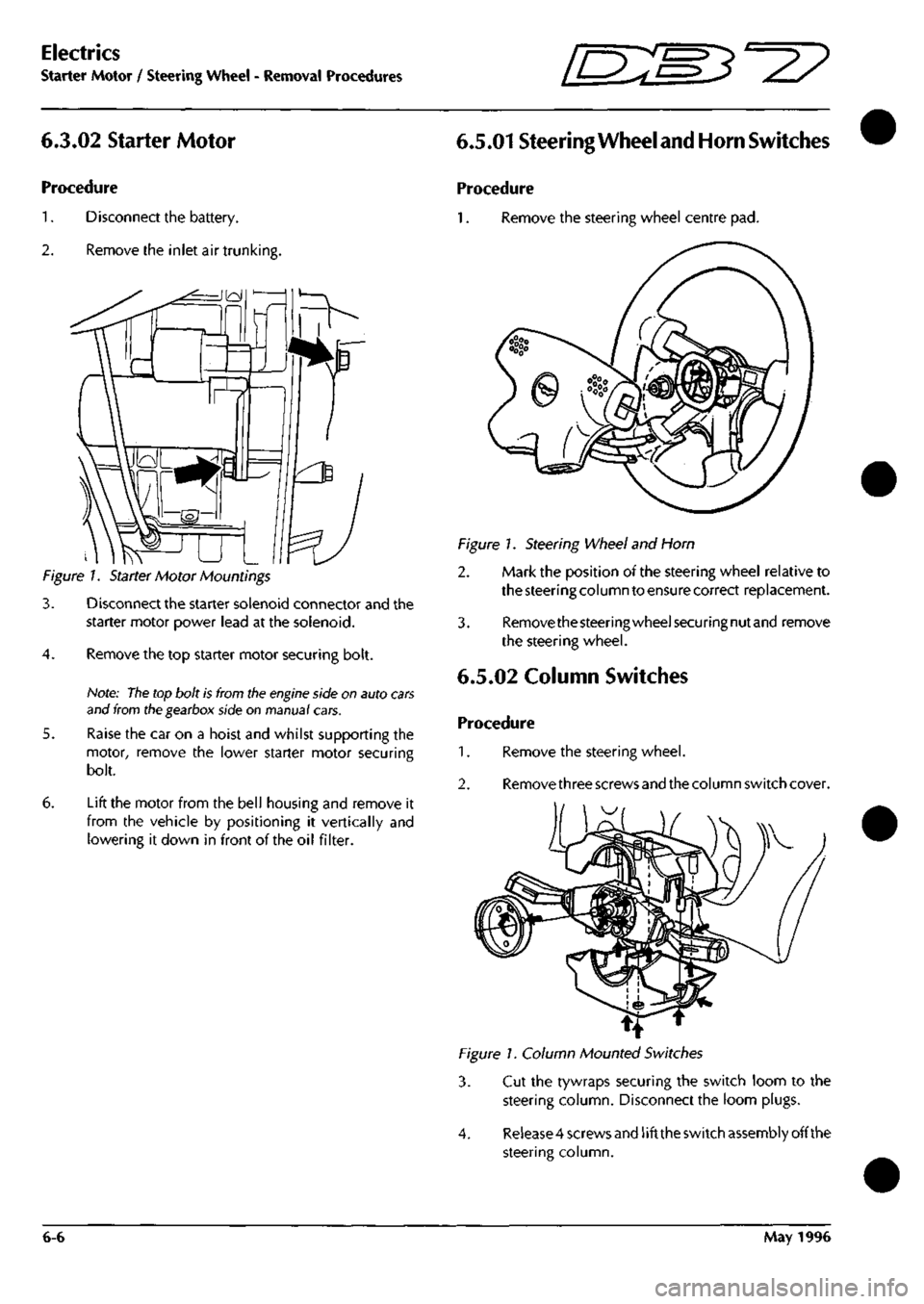
Electrics
Starter Motor / Steering Wheel - Removal Procedures ^n:M3^^2?
6.3.02 Starter Motor
Procedure
1.
Disconnect the battery.
2.
Remove the inlet air trunkins
Figure 1. Starter Motor Mountings
3. Disconnect the starter solenoid connector and the
starter motor power lead at the solenoid.
4.
Remove the top starter motor securing bolt.
Note:
The
top bolt is from tlie
engine
side on auto
cars
and from ttie gearbox side on manual cars.
5. Raise the car on a hoist and whilst supporting the
motor, remove the lower starter motor securing
bolt.
6. Lift the motor from the bell housing and remove it
from the vehicle by positioning it vertically and
lowering it down in front of the oil filter.
6.5.01 Steering
Wheel and Horn
Switches
Procedure
1.
Remove the steering wheel centre pad.
Figure 1. Steering Wheel and Horn
2. Mark the position of the steering wheel relative to
the steering column to ensure correct replacement.
3. Removethesteeringwheelsecuringnutand remove
the steering wheel.
6.5.02 Column Switches
Procedure
1.
Remove the steering wheel.
2.
Remove three screws and the column switch cover.
1^
Figure 1. Column Mounted Switches
3. Cut the tywraps securing the switch loom to the
steering column. Disconnect the loom plugs.
4.
Release 4 screws and
1
ift the switch assembly off the
steering column.
6-6 May 1996
Page 15 of 421
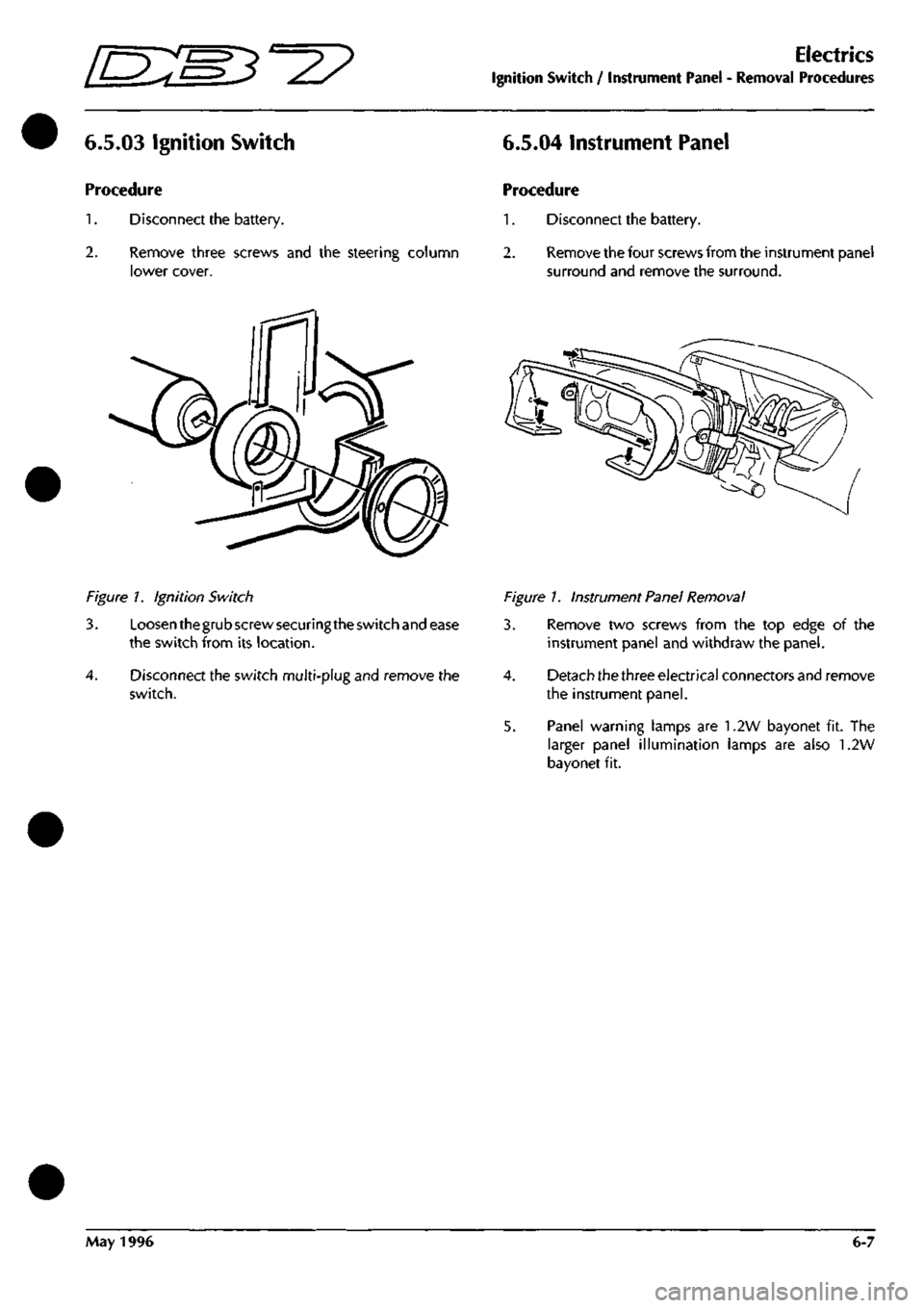
Em3^^^
Electrics
Ignition Switch / Instrument Panel - Removal Procedures
6.5.03 Ignition Switch 6.5.04 Instrument Panel
Procedure
1.
Disconnect the battery.
2.
Remove three screws and the steering column
lower cover.
Procedure
1.
Disconnect the battery.
2.
Remove the four screws from the instrument pane!
surround and remove the surround.
Figure 7. Ignition Switch
3.
4.
Loosen thegrub screw securing the switch and ease
the switch from its location.
Disconnect the switch multi-plug and remove the
switch.
Figure 1. Instrument Panel Removal
3. Remove two screws from the top edge of the
instrument panel and withdraw the panel.
4.
Detach the three electrical connectors and remove
the instrument panel.
5. Panel warning lamps are 1.2W bayonet fit. The
larger panel illumination lamps are also 1.2W
bayonet fit.
May 1996 6-7
Page 185 of 421
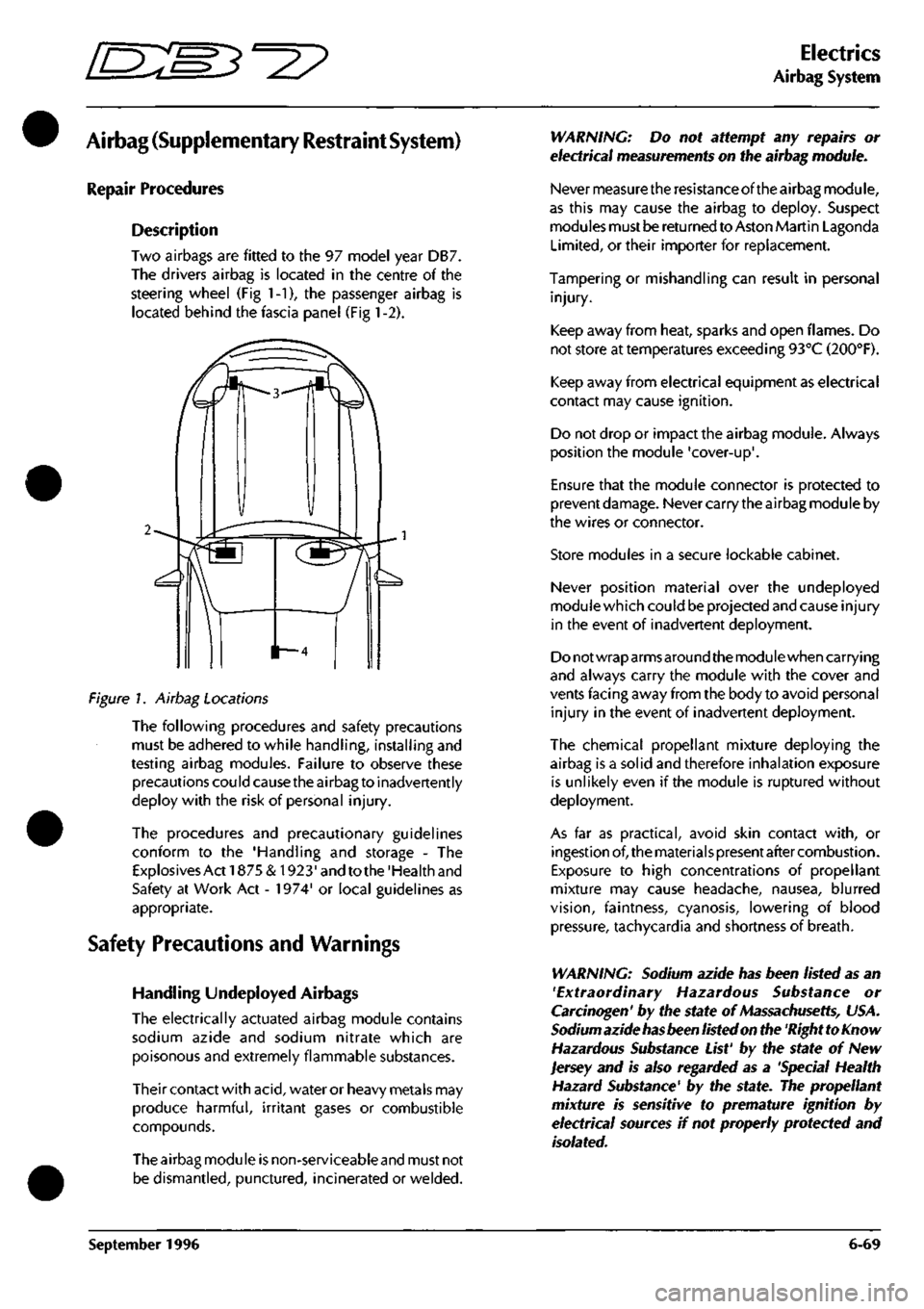
Electrics
Airbag System
Airbag (Supplementary Restraint System)
Repair Procedures
Description
Two airbaes are fitted to the 97 model year DB7.
The drivers airbag is located in the centre of the
steering wheel (Fig 1-1), the passenger airbag is
located behind the fascia panel (Fig 1-2).
Figure!. Airbag Locations
The following procedures and safety precautions
must be adhered to while handling, installing and
testing airbag modules. Failure to observe these
precautions could cause the airbag to inadvertently
deploy with the risk of personal injury.
The procedures and precautionary guidelines
conform to the 'Handling and storage - The
Explosives Act 1875 & 1923' and to the 'Health and
Safety at Work Act - 1974' or local guidelines as
appropriate.
Safety Precautions and Warnings
Handling Undeployed Airbags
The electrically actuated airbag module contains
sodium azide and sodium nitrate which are
poisonous and extremely flammable substances.
Their contact with
acid,
water or heavy metals may
produce harmful, irritant gases or combustible
compounds.
The airbag module is non-serviceable and must not
be dismantled, punctured, incinerated or welded.
WARNING: Do not attempt any repairs or
electrical measurements on the airbag module.
Never measure the resistance of the airbag module,
as this may cause the airbag to deploy. Suspect
modules must be returned to Aston Martin Lagonda
Limited,
or their importer for replacement.
Tampering or mishandling can result in personal
injury.
Keep away from heat, sparks and open flames. Do
not store at temperatures exceeding 93°C (200°F).
Keep away from electrical equipment as electrical
contact may cause ignition.
Do not drop or impact the airbag module. Always
position the module 'cover-up'.
Ensure that the module connector is protected to
prevent damage. Never carry the airbag module by
the wires or connector.
Store modules in a secure lockable cabinet.
Never position material over the undeployed
module which could be projected and cause injury
in the event of inadvertent deployment.
Do not wrap arms around the module when carrying
and always carry the module with the cover and
vents facing away from the body to avoid personal
injury in the event of inadvertent deployment.
The chemical propellant mixture deploying the
airbag is a solid and therefore inhalation exposure
is unlikely even if the module is ruptured without
deployment.
As far as practical, avoid skin contact
with,
or
ingestion of, the materials present after combustion.
Exposure to high concentrations of propellant
mixture may cause headache, nausea, blurred
vision,
faintness, cyanosis, lowering of blood
pressure, tachycardia and shortness of breath.
WARNING: Sodium azide has been listed as an
'Extraordinary Hazardous Substance or
Carcinogen' by the state of
Massachusetts,
USA.
Sodium azide has been listed on the
'Right
to Know
Hazardous Substance
List'
by the state of New
Jersey and is also regarded as a 'Special Health
Hazard Substance' by the state. The propellant
mixture is sensitive to premature ignition by
electrical sources if not properly protected and
isolated.
September 1996 6-69
Page 187 of 421
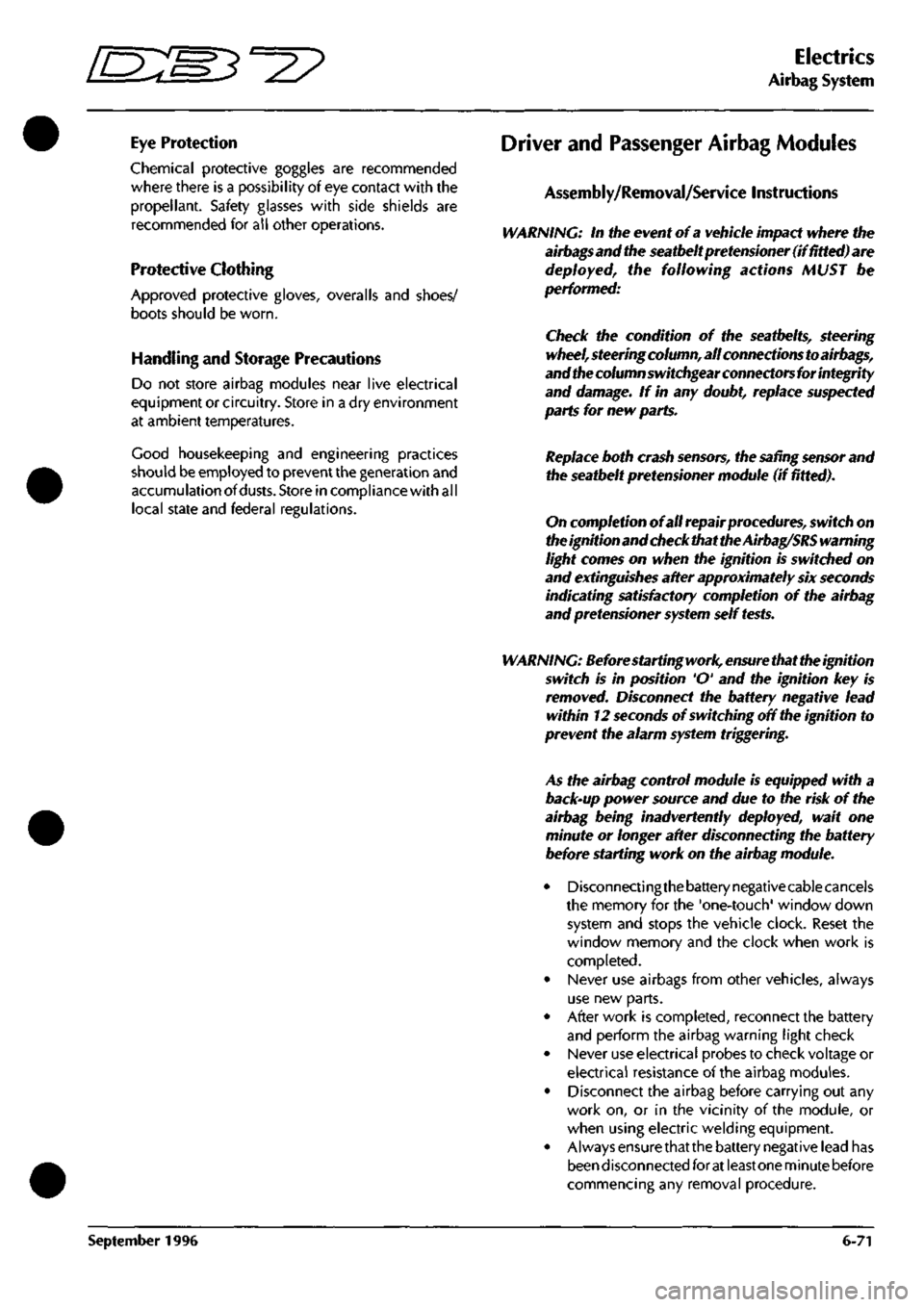
^=2?
Electrics
Airbag System
Eye Protection
Chemical protective goggles are recommended
where there is a possibility of eye contact with the
propellant. Safety glasses with side shields are
recommended for all other operations.
Protective Clothing
Approved protective gloves, overalls and shoes/
boots should be worn.
Handling and Storage Precautions
Do not store airbag modules near live electrical
equipment or circuitry. Store in a dry environment
at ambient temperatures.
Good housekeeping and engineering practices
should be employed to prevent the generation and
accumulation of
dusts.
Store in compliance with all
local state and federal regulations.
Driver and Passenger Airbag Modules
Assembly/Removal/Service Instructions
WARNING: In the event of a vehicle impact where the
airbags and the seatbeltpretensioner (if fitted) are
deployed, the following actions MUST be
performed:
Check the condition of the seatbelts, steering
wheel,
steering column, all connections to airbags,
and the column switchgear connectors for integrity
and damage. If in any
doubt,
replace suspected
parts for new parts.
Replace both crash
sensors,
the
safing sensor
and
the seatbelt pretensioner module (if fitted).
On completion of all repair procedures, switch on
the ignition and check that the
Airbag/SRS
warning
light comes on when the ignition is switched on
and extinguishes after approximately six seconds
indicating satisfactory completion of the airbag
and pretensioner
system
self
tests.
WARNING: Before starting
work,
ensure
that the ignition
switch is in position 'O' and the ignition key is
removed.
Disconnect the battery negative lead
within 12 seconds of switching off the ignition to
prevent the alarm system triggering.
As the airbag control module is equipped with a
back-up power source and due to the risk of the
airbag being inadvertently deployed, wait one
minute or longer after disconnecting the battery
before starting work on the airbag module.
• Disconnectingthe battery negative cable cancels
the memory for the 'one-touch' window down
system and stops the vehicle clock. Reset the
window memory and the clock when work is
completed.
• Never use airbags from other vehicles, always
use new parts.
• After work is completed, reconnect the battery
and perform the airbag warning light check
• Never use electrical probes to check voltage or
electrical resistance of the airbag modules.
• Disconnect the airbag before carrying out any
work on, or in the vicinity of the module, or
when using electric welding equipment.
• Always ensure that the battery negative lead has
been disconnected for at least one minute before
commencing any removal procedure.
September 1996 6-71
Page 191 of 421
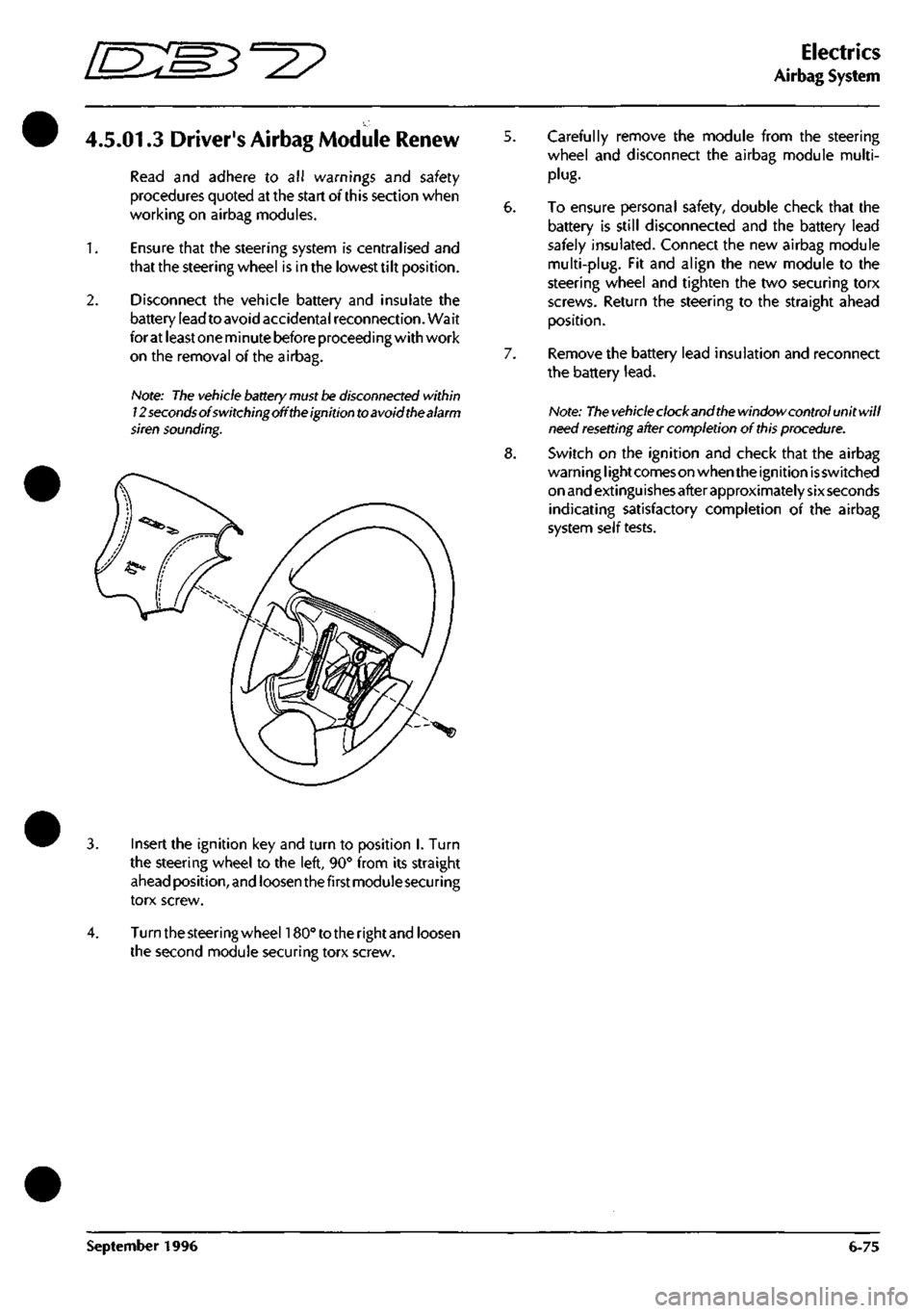
'=2?
Electrics
Airbag System
4.5.01.3 Driver's Airbag Module Renew
Read and adhere to all warnings and safety
procedures quoted at the start of this section when
working on airbag modules.
1.
Ensure that the steering system is centralised and
that the steering wheel is in the lowest tilt position.
2.
Disconnect the vehicle battery and insulate the
battery lead to avoid accidental reconnection. Wait
for at least one minute before proceeding with work
on the removal of the airbag.
Hote: The vehicle battery
must be
disconnected within
12 seconds of switching off
the
ignition to avoid the alarm
siren sounding.
5. Carefully remove the module from the steering
wheel and disconnect the airbag module multi-
plug.
6. To ensure personal safety, double check that the
battery is still disconnected and the battery lead
safely insulated. Connect the new airbag module
multi-plug.
Fit and align the new module to the
steering wheel and tighten the two securing torx
screws. Return the steering to the straight ahead
position.
7. Remove the battery lead insulation and reconnect
the battery
lead.
Note:
The vehicle
clockandthe window control unitwill
need
resetting
after completion of
this
procedure.
8. Switch on the ignition and check that the airbag
warni ng
I
ight comes on when the ignition is switched
on and extinguishes after approximately sixseconds
indicating satisfactory completion of the airbag
system self tests.
Insert the ignition key and turn to position I. Turn
the steering wheel to the left, 90° from its straight
ahead position, and loosen thefirstmoduiesecuring
torx screw.
Turn the steering wheehSO" to the rightand loosen
the second module securing torx screw.
September 1996 6-75
Page 194 of 421
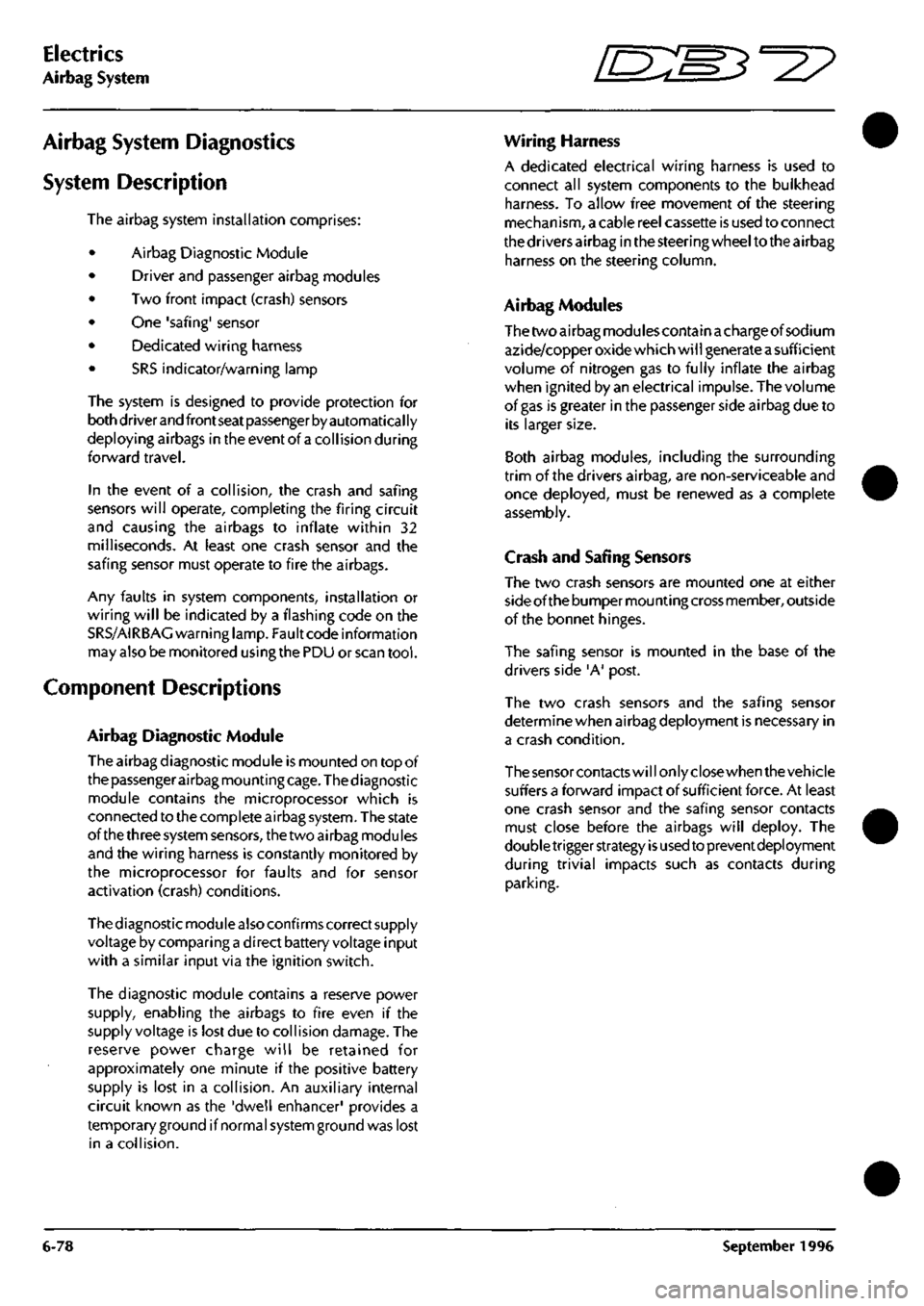
Electrics
Airbag System '=2?
Airbag System Diagnostics
System Description
The airbag system installation comprises:
Airbag Diagnostic Module
Driver and passenger airbag modules
Two front impact (crash) sensors
One 'safing' sensor
Dedicated wiring harness
SRS indicator/warning lamp
The system is designed to provide protection for
both driver and front seat passenger by automatical ly
deploying airbags in the event of
a
collision during
forward travel.
In the event of a collision, the crash and safing
sensors will operate, completing the firing circuit
and causing the airbags to inflate within 32
milliseconds. At least one crash sensor and the
safing sensor must operate to fire the airbags.
Any faults in system components, installation or
wiring will be indicated by a flashing code on the
SRS/AIRBAG warning lamp. Fault code information
may also be monitored using the PDU or scan
tool.
Component Descriptions
Airbag Diagnostic Module
The airbag diagnostic module is mounted on top of
the passenger airbag mountingcage.Thediagnostic
module contains the microprocessor which is
connected to the complete airbag system. The state
of the three system sensors, the two airbag modules
and the wiring harness is constantly monitored by
the microprocessor for faults and for sensor
activation (crash) conditions.
The diagnostic module also confirms correct supply
voltage by comparing
a
direct battery voltage input
with a similar input via the ignition switch.
The diagnostic module contains a reserve power
supply, enabling the airbags to fire even if the
supply voltage is lost due to collision damage. The
reserve power charge will be retained for
approximately one minute if the positive battery
supply is lost in a collision. An auxiliary internal
circuit known as the 'dwell enhancer' provides a
temporary ground if normal system ground was lost
in a collision.
Wiring Harness
A dedicated electrical wiring harness is used to
connect all system components to the bulkhead
harness. To allow free movement of the steering
mechanism, a cable reel cassette is used to connect
the drivers airbag in the steering wheel to the airbag
harness on the steering column.
Airbag Modules
The two airbag modules contain achargeof sodium
azide/copper oxide which wi
11
generate
a
sufficient
volume of nitrogen gas to fully inflate the airbag
when ignited by an electrical impulse. The volume
of gas is greater in the passenger side airbag due to
its larger size.
Both airbag modules, including the surrounding
trim of the drivers airbag, are non-serviceable and
once deployed, must be renewed as a complete
assembly.
Crash and Safing Sensors
The two crash sensors are mounted one at either
side of the bumper mounting cross member, outside
of the bonnet hinges.
The safing sensor is mounted in the base of the
drivers side 'A' post.
The two crash sensors and the safing sensor
determine when airbag deployment is necessary in
a crash condition.
The sensor contacts will only close when the vehicle
suffers a forward impact of sufficient force. At least
one crash sensor and the safing sensor contacts
must close before the airbags will deploy. The
doubletrigger strategy
is
used to prevent deployment
during trivial impacts such as contacts during
parking.
6-78 September 1996
Page 196 of 421
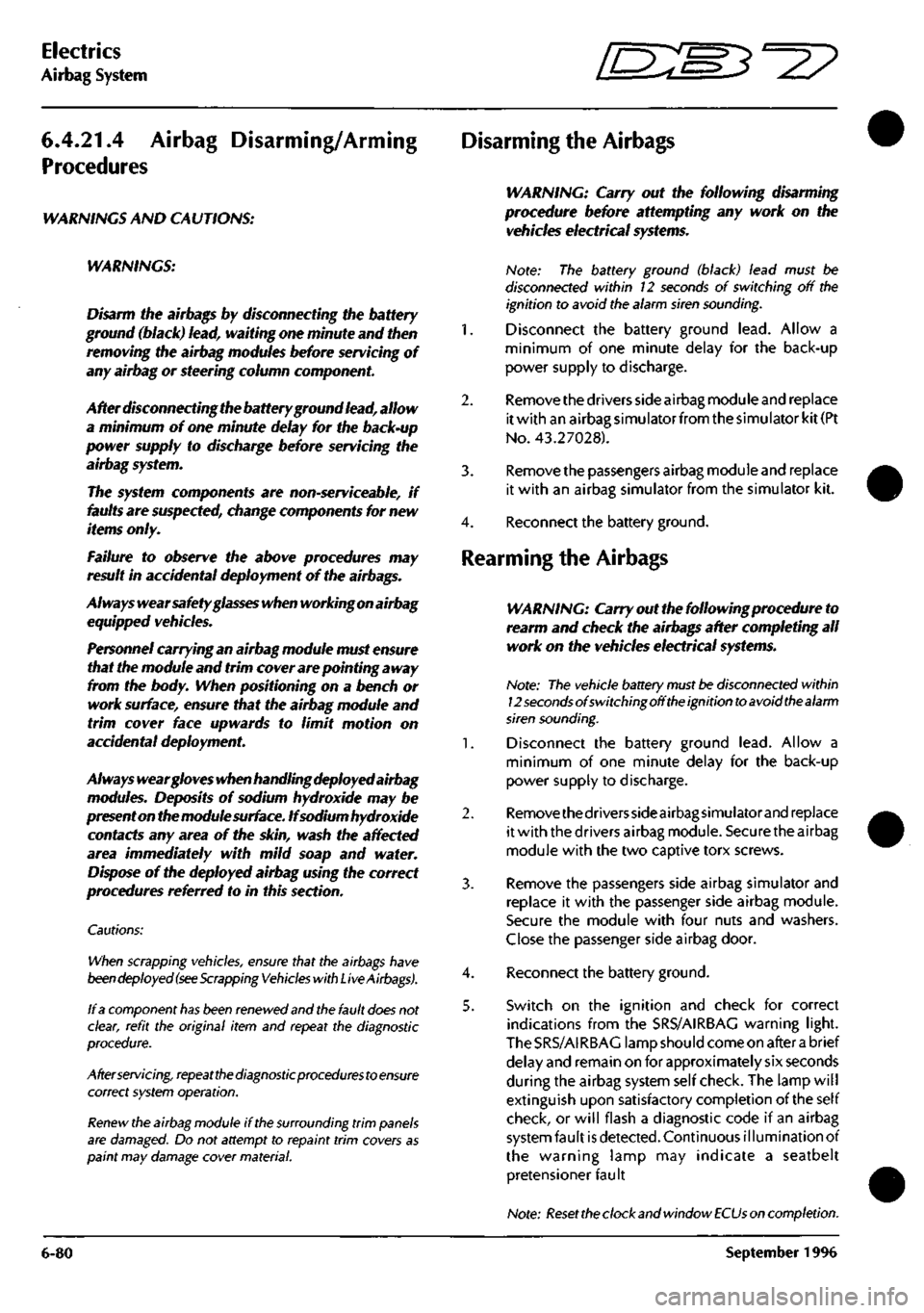
Electrics
Airbag System ^2?
6.4.21.4
Airbag Disarming/Arming
Procedures
WARNINGS AND CAUTIONS:
WARNINGS:
Disarm the airbags by disconnecting the battery
ground (black)
lead,
waiting one minute and then
removing the airbag modules before servicing of
any airbag or steering column component.
After disconnecting the battery ground
lead,
allow
a minimum of one minute delay for the back-up
power supply to discharge before servicing the
airbag system.
The system components are non-serviceable, if
faults are
suspected,
change components for new
items
only.
Failure to observe the above procedures may
result in accidental deployment of the airbags.
Always wear safety
glasses
when working on airbag
equipped vehicles.
Personnel carrying an airbag module must ensure
that the module and trim cover are pointing away
from the
body.
When positioning on a bench or
work surface, ensure that the airbag module and
trim cover face upwards to limit motion on
accidental deployment.
Always wear
gloves
when handling deployed airbag
modules. Deposits of sodium hydroxide may be
presenton the module surface. If sodium hydroxide
contacts any area of the skin, wash the affected
area immediately with mild soap and
water.
Dispose of the deployed airbag using the correct
procedures referred to in this section.
Cautions:
When scrapping vehicles,
ensure
that the
airbags
have
been deployed (see
Scrapping Vehicles
with Live
Airbags).
If a component
has been
renewed and the fault
does
not
clear,
refit the original item and repeat the diagnostic
procedure.
After
servicing,
repeatthe diagnostic
procedures
to ensure
correct
system
operation.
Renew
the airbag module if the surrounding trim
panels
are
damaged.
Do not attempt to repaint trim covers as
paint may
damage
cover material.
Disarming the Airbags
3.
4.
WARNING: Carry out the following disarming
procedure before attempting any work on the
vehicles electrical
systems.
Note: The battery ground (black) lead must be
disconnected within 12 seconds of switching off the
ignition to avoid the alarm siren sounding.
Disconnect the battery ground
lead.
Allow a
minimum of one minute delay for the back-up
power supply to discharge.
Remove the drivers side airbag module and replace
it with an airbag simulatorfrom the simulator kit (Pt
No.
43.27028).
Remove the passengers airbag module and replace
it with an airbag simulator from the simulator kit.
Reconnect the battery ground.
Rearming the Airbags
WARNING: Carry out the following procedure to
rearm and check the airbags after completing all
work on the vehicles electrical
systems.
Note: The vehicle battery
must be
disconnected within
12
seconds
of switching off
the
ignition
to
avoid the alarm
siren sounding.
^. Disconnect the battery ground
lead.
Allow a
minimum of one minute delay for the back-up
power supply to discharge.
2.
Removethedriverssideairbagsimulatorand replace
it with the drivers airbag module. Secure the airbag
module with the two captive torx screws.
3. Remove the passengers side airbag simulator and
replace it with the passenger side airbag module.
Secure the module with four nuts and washers.
Close the passenger side airbag door.
4.
Reconnect the battery ground.
5. Switch on the ignition and check for correct
indications from the SRS/AIRBAG warning light.
TheSRS/AIRBAC lamp should come on after
a
brief
delay and remain on for approximately six seconds
during the airbag system self check. The lamp will
extinguish upon satisfactory completion of the self
check, or will flash a diagnostic code if an airbag
system fault is detected. Continuous illumination of
the warning lamp may indicate a seatbelt
pretensioner fault
Note:
Reset the
clock and window
ECUs
on completion.
6-80 September 1996
Page 202 of 421

Electrics
Airbag System ^2?
Airbag DM Fault Code 13
Airbag circuit short to ground
Normal Operation
The diagnostic modu
le
measures the voltage at pins
2-5 and 2-6. The voltage at these pins is dependant
on charging system voltage as shown in the table
belovi-.
'in 2-5
2.3V
2.4 V
2.5V
2.7V
2.8V
3.0V
3.1V
3.2V
3.4V
3.5V
3.7V
3.8V
4.0V
4.1V
4.3V
Pin 2-6
2.3V
2.4V
2.5V
2.7V
2.8V
3.0V
3.1V
3.2V
3.4V
3.5V
3.7V
3.8V
4.0V
4.1V
4.3V
Charge Volts
9.0V
9.5V
lO.OV
10.5V
11.OV
11.5V
12.0V
12.5V
13.0V
13.5V
14.0V
14.5V
15.0V
15.5V
16.0V
If the diagnostic monitor measures a voltage of 2.0
volts or less on pins 2-5 and 2-6, a fau It code 13 will
be generated and flashed to the instrument pack to
be signalled on the airbag warning lamp. Voltages
as low as 2.0 volts indicate a possible short to
ground in these circuits.
When generating a code 13 the diagnostic module
also generates a signal to blow its own internal
thermal fuse. This action disables the airbag
deployment circuit. The airbag diagnostic module
fuse is non-repairable and the module must be
replaced after repairing the short circuit, if the
voltage at pins 2-5 and 2-6 returns to normal, fault
code 51 (blown thermal fuse) will be stored in
memory.
6.
Fault Analysis
WARNING: Read and adhere to all warnings and
safety procedures at the start of this section when
working on the airbag
system.
Disarm the airbag system and fit airbag simulators
(6.4.21.4)
Disconnect the airbag diagnostic module. Switch
on the ignition.
Measure the continuity to ground at the following
pins on the diagnostic module harness connector:
2-2 Passenger airbag feed
2-3 Passenger airbag return
2-4 Drivers airbag return
2-5 Drivers airbag feed
2-11 Safing sensor feed
If no short circuit is detected, go to step 4.
If
a
short circuit is detected, disconnect the relevant
airbag simulator or the safing sensor and repeat the
continuity measurement to isolate the circuit fault.
Service the wiring or replace the safing sensor as
necessary. Fit a new airbag diagnostic module and
rearm the airbags (6.4.21.4).
Check for intermittent short circuits in the cable
reel cassette. Monitor the continuity to ground at
pins 2-4 and 2-5 whilst rotating the steering from
lock to lock in both directions.
If no short circuit is detected, go to step 5.
If a short circuit is detected, replace the column
switchgear assembly. Fit a new airbag diagnostic
module and rearm the airbags (6.4.21.4).
WARNING: Do not attempt to make any electrical
measurements on the airbag
modules.
Any induced
voltage can
cause
the airbag
to
deploy with the
risk
of personal
injury.
Fit a replacement diagnostic module and
replacement airbag modules.
Caution: Do not refit
the
old
airbag
modules.
They may
be faulty and would
damage the
new diagnostic module.
Rearm the airbag system (6.4.21.4).
6-86 September 1996